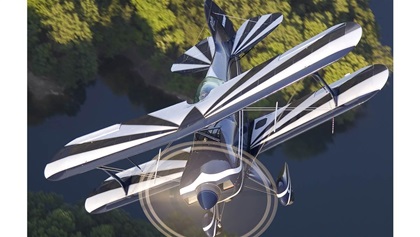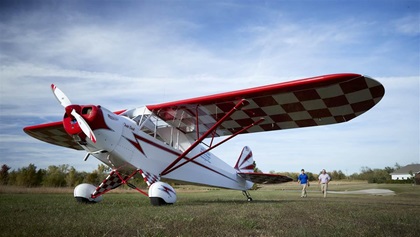The customer: You love adventure.
The mission: Flying makes you feel like a cowboy of the skies. You love the thrill of going upside down, you and your flying friends regularly do formation flying, and your idea of great airport food is the cheese crackers in the vending machine. Your goal isn’t to go anywhere but up, and traveling doesn’t interest you. As a bonus you have access to a hangar, and you live close to the airport, so you fly often and always keep your skills sharp. We asked backcountry “airplane whisperer” Kyle Bushman, owner of Creswell, Oregon’s Ragwood Refactory for his suggestions (see “Beauty or the Beast,” June 2020 AOPA Pilot).
The budget: $50,000
Email [email protected]
The options:
Cessna 150/152 Aerobat
 Bushman says the Cessna 150 Aerobat is his first choice, as it can be found in the $35,000 to $50,000 range. It will be a familiar airplane to a lot of pilots since it’s a Cessna trainer. After the Cessna 172, the Cessna 150/152 series was the second-best-selling Cessna aircraft. But the Aerobat is unique in its abilities to do aerobatics. Cessna introduced the Aerobat in 1970. It had the 100-horsepower Continental O-200 all 150s used, but differed from the original 150 in having more structural strength, being rated plus 6/minus 3 Gs. Other aerobatic features include four-point harnesses for pilot and passenger (if you must), dual overhead skylights for awesome visibility (which, while standard on the Cessna 140, were not part of the 150 design), jettison doors, and removable seat cushions so that parachutes can be worn. In 1970, the Aerobat cost $12,000.
Bushman says the Cessna 150 Aerobat is his first choice, as it can be found in the $35,000 to $50,000 range. It will be a familiar airplane to a lot of pilots since it’s a Cessna trainer. After the Cessna 172, the Cessna 150/152 series was the second-best-selling Cessna aircraft. But the Aerobat is unique in its abilities to do aerobatics. Cessna introduced the Aerobat in 1970. It had the 100-horsepower Continental O-200 all 150s used, but differed from the original 150 in having more structural strength, being rated plus 6/minus 3 Gs. Other aerobatic features include four-point harnesses for pilot and passenger (if you must), dual overhead skylights for awesome visibility (which, while standard on the Cessna 140, were not part of the 150 design), jettison doors, and removable seat cushions so that parachutes can be worn. In 1970, the Aerobat cost $12,000.
Pitts S–1
 “Coolness factor.” That’s what Bushman says gets the Pitts single-seat S–1C on his list. The aerobatic biplane can be acquired in the $30,000 to $35,000 range. It’s taught many pilots to fly aerobatics; its throaty roar thrills airshow attendees; and it has a rich, storied history—the Little Stinker hangs upside down in the Smithsonian National Air and Space Museum. The Pitts may be small, but it has exceptional handling qualities, is sprite-like on takeoff, and is playful and seemingly full of energy (if you anthropomorphize). This is a perfect airplane for that “loner” we described—it’s a bit drafty and the straight-back seats are uncomfortable, but it is the cowboy way to suffer for one’s passion.
“Coolness factor.” That’s what Bushman says gets the Pitts single-seat S–1C on his list. The aerobatic biplane can be acquired in the $30,000 to $35,000 range. It’s taught many pilots to fly aerobatics; its throaty roar thrills airshow attendees; and it has a rich, storied history—the Little Stinker hangs upside down in the Smithsonian National Air and Space Museum. The Pitts may be small, but it has exceptional handling qualities, is sprite-like on takeoff, and is playful and seemingly full of energy (if you anthropomorphize). This is a perfect airplane for that “loner” we described—it’s a bit drafty and the straight-back seats are uncomfortable, but it is the cowboy way to suffer for one’s passion.
Clipped-wing Piper J-3 Cub
 “Checks all the boxes” is Bushman’s explanation for the Piper J–3 Cub on his list. There is no one aircraft model that symbolizes general aviation and the seduction of flying low and slow more than the iconic Piper J–3 Cub. This is the airplane that taught the pilots of the Greatest Generation and World War II to fly. And it’s the aircraft those soldiers returned home to hope to stick in a hangar of their own. Easy to fly, easy to own. It’s a fabric-covered aircraft and most models are the standard 65-horsepower version. A small number of J–3 Cubs have been modified for limited aerobatics by removing 40 inches from the root of each wing—inspiring the clipped-wing moniker—and installing 85- or 90-horsepower engines. With less wing and more power, the Cub leaps off the ground and dances in the sky. This isn’t your grandfather’s airplane, and you can find one for less than $50,000.
“Checks all the boxes” is Bushman’s explanation for the Piper J–3 Cub on his list. There is no one aircraft model that symbolizes general aviation and the seduction of flying low and slow more than the iconic Piper J–3 Cub. This is the airplane that taught the pilots of the Greatest Generation and World War II to fly. And it’s the aircraft those soldiers returned home to hope to stick in a hangar of their own. Easy to fly, easy to own. It’s a fabric-covered aircraft and most models are the standard 65-horsepower version. A small number of J–3 Cubs have been modified for limited aerobatics by removing 40 inches from the root of each wing—inspiring the clipped-wing moniker—and installing 85- or 90-horsepower engines. With less wing and more power, the Cub leaps off the ground and dances in the sky. This isn’t your grandfather’s airplane, and you can find one for less than $50,000.
Let us know which aircraft you would choose!



